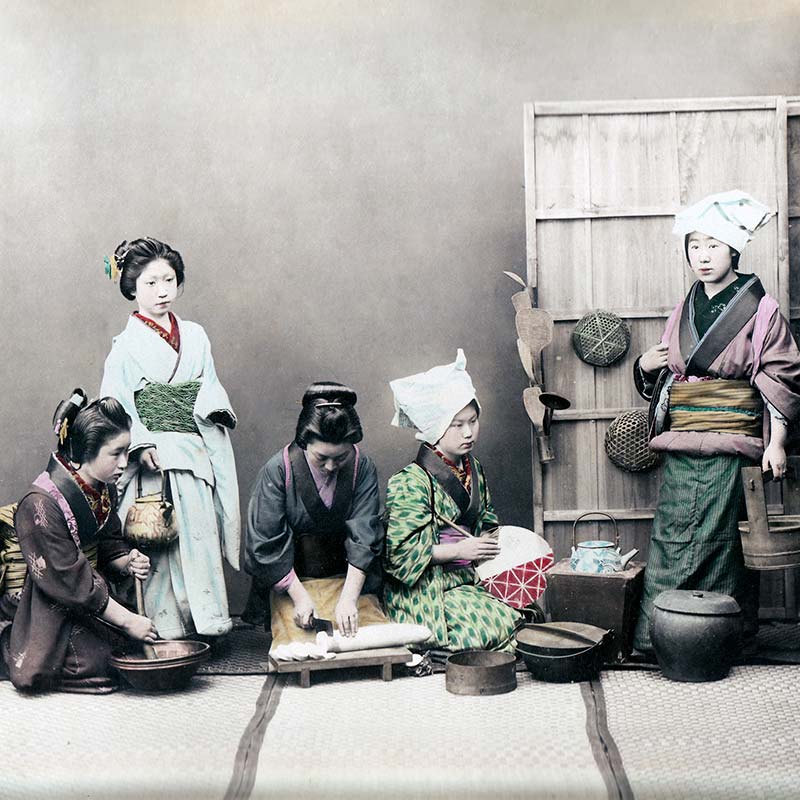Two young men are relaxing in a fish shop. Fish has always been an important part of the Japanese diet and was sold both at shops and by fish peddlers (furiuri) who walked around carrying fish in tubs that hung from a carrying pole on their shoulder.
Before the age of refrigeration, fish was often kept fresh by keeping it alive in tubs or barrels filled with water. A barrel is actually visible on the right of this photograph. Although it appears wet, it is not sure if this one was used for keeping live fish.
As Japan modernized starting in the Meiji Period, the Japanese fish industry followed suit and became increasingly important to the country’s economy and food supply.
After the Russo-Japanese War, Japan gained significant fishing rights in sections of Siberian waters through the 1905 Treaty of Portsmouth. These rights were extended in later years.1
By the late thirties this area accounted for a quarter of Japan’s catch. By this time, distant-water fishing, started around the 1920s, played a major role, too. Japan’s fishing industry now employed 1.5 million people and had a total catch worth JPY 400 million per year. (At the time JPY 1.00 was worth about USD 3.50.)2
It might be difficult to imagine this today when the country imports most of its food products, but at the time Japan lead the world in output of fishery products.3
As the fishing industry grew increasingly important, the methods of keeping fish fresh kept up with the times. During the 1930s, the Japanese Government Railways even used a special live fish car.4

Japan’s custom of delivering live fish survives to this day. Many restaurants keep aquariums, while special delivery trucks with tanks full of water transport fish all over the country.
It is no surprise that Japan has developed such an intricate distribution system. Together with Iceland, the country has the highest consumption of fish in the world. Today, the average Japanese eats close to 70 kilograms (154 lbs) of fish per year.5
The photo of the fish shop is featured in Japan, Described and Illustrated by the Japanese, edited by Captain F Brinkley.6
The photographs for this publication were sourced by Kozaburo Tamamura (1856-1923?), but it is not known who the photographer is of this image.
Notes
1 Wikipedia, Treaty of Portsmouth: Text: ARTICLE XI. Retrieved on 2008-02-23.
2 Global Financial Data, Japan Yen (Sample Data): July 31, 1862-February 21, 2008. Retrieved on 2008-02-23.
3 Nagaharu, Yasuo (Apr. 26, 1939). The North Ocean Fishery in Japan’s Economic Life, Far Eastern Survey, Vol. 8, No. 9: 106-108
4 1933. Live-fish vans for Japanese Rys, The Locomotive, Magazine and Railway Carriage and Wagon Review: 182
5 Nishimura, Masashi (August 2007). Nutritional Advantage of Fish Diet Highlighted in FY2006 Fisheries White Paper (pdf), Japan Fisheries Association: 1
6 Captain Brinkley, Frank (1897). Japan, Described and Illustrated by the Japanese, Shogun Edition. J B Millet Company.
Published
Updated
Reader Supported
Old Photos of Japan aims to be your personal museum for Japan's visual heritage and to bring the experiences of everyday life in old Japan to you.
To enhance our understanding of Japanese culture and society I track down, acquire, archive, and research images of everyday life, and give them context.
I share what I have found for free on this site, without ads or selling your data.
Your support helps me to continue doing so, and ensures that this exceptional visual heritage will not be lost and forgotten.
Thank you,
Kjeld Duits
Reference for Citations
Duits, Kjeld (). 1890s: Fish Shop, OLD PHOTOS of JAPAN. Retrieved on December 12, 2025 (GMT) from https://www.oldphotosjapan.com/photos/57/fish-shop




BERNHARD
I NEED ANDY MESSAGE ABOUT THE IMPORTANT OF FISH IN THE COUNTRY ECONOMY
YOURS IS
BERNHARD
#000372 ·